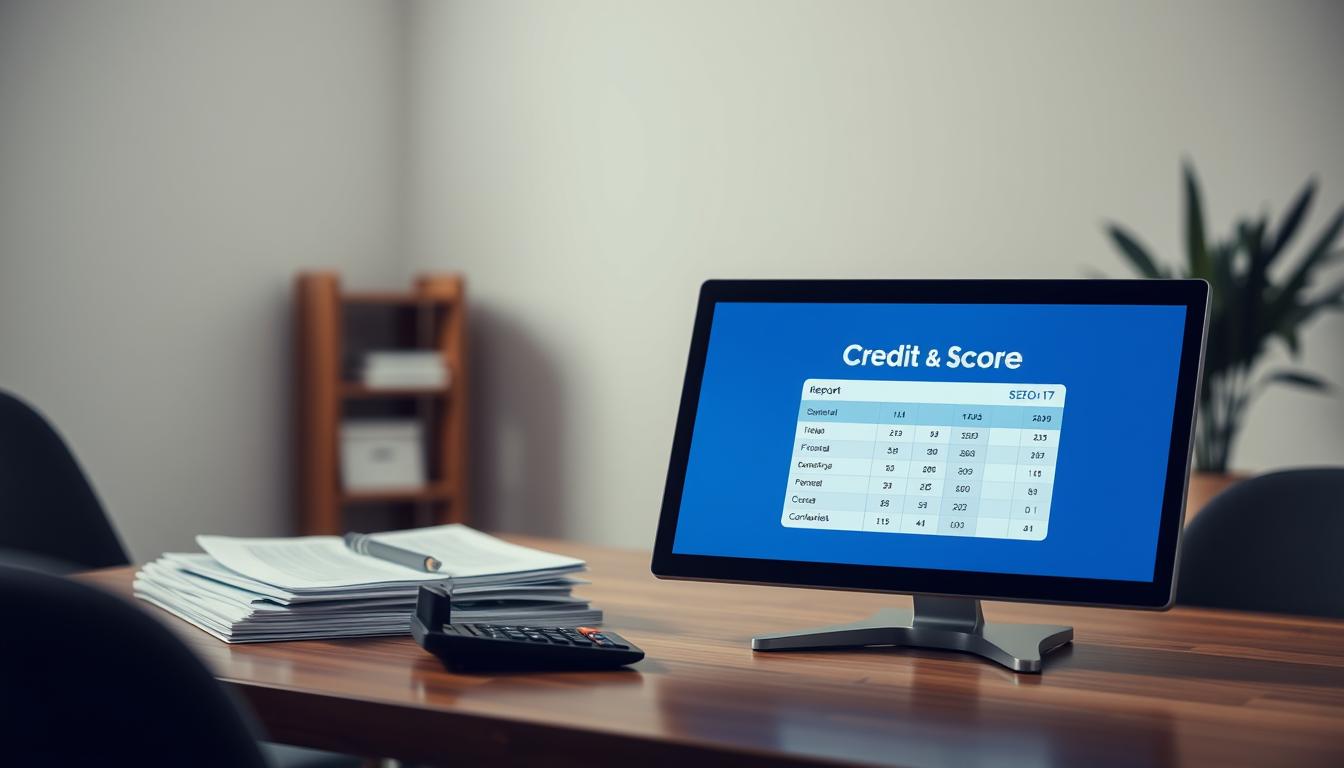Want better rates and easier approvals? This short guide gives practical, U.S.-focused steps you can use now to move your rating in the right direction.
The number you see on reports comes from different bureaus and models. FICO ranges from 300 to 850, and a value near 760 unlocks the best terms. Lenders look at payment history, utilization, account age, mix, amounts owed, and hard inquiries.
Quick wins matter, but steady habits matter more. Lower revolving balances, avoid unnecessary hard pulls, and keep older accounts active to help your profile over time.
We also cover how to review reports from Equifax, Experian, and TransUnion so you can dispute errors. If you are rebuilding, learn simple options like secured cards, authorized user status, and rent reporting.
Key Takeaways
- Focus on payment history and low utilization to see the biggest short-term gains.
- Check all three bureaus and dispute inaccuracies that hurt your record.
- Use existing accounts wisely: request higher limits and keep older lines open.
- Avoid unnecessary hard inquiries and lower revolving balances first.
- Rebuilding options include secured cards and authorized user status.
Why “Credit Score Fast” Matters Right Now
Smart adjustments today can shift where lenders place you in pricing tiers.
Fast usually means weeks to a few months of steady actions, not an overnight fix. FICO runs from 300 to 850; moving into the 740–799 or 800+ bands often yields markedly better rates. The U.S. average sits near 718, so modest gains can cut borrowing costs.
Targeted steps that affect major factors—timely payments and lower revolving balances—can show results within a month or two. Check reports free at AnnualCreditReport.com and use your bank or card issuer to view current values.
- Pay down balances before the statement date to reduce reported utilization.
- Set autopay to prevent missed payments and update on-time history.
- Avoid new applications so fewer inquiries appear to lenders.
| Action | Expected time | Why it helps lenders view you better |
|---|---|---|
| Pay balances before cut date | 1 billing cycle | Reduces utilization reported to bureaus |
| Set autopay | Immediate | Prevents late payments, improves payment history |
| Dispute report errors | Weeks to months | Removes negative marks that lower risk profiles |
| Pause new applications | Ongoing | Limits hard inquiries that signal new risk |
How Credit Scores Work: Payment History, Utilization Rate, Age, Mix, and Inquiries
Scoring models condense past behavior into a number that lenders use to set rates and terms. FICO and VantageScore weigh the same core items, but each model and bureau can show slightly different values.
FICO and VantageScore basics: ranges and major factors
FICO weights: payment history 35%, amounts owed 30%, length of history 15%, new credit 10%, and mix 10%.
- These factors translate your payment history, utilization, account age, new inquiries, and mix into a single credit score.
- VantageScore uses similar inputs but may score some actions differently, so numbers vary across models.
What lenders see from Equifax, Experian, and TransUnion
Not every creditor reports to all three bureaus. That creates multiple reports and sometimes different scores for the same person.
One way to protect yourself is to check all three reports and dispute errors that appear on any file.
Biggest factor first: avoiding late payments and delinquencies
“A single 30-day late payment can drop a score sharply and stay on a report for up to seven years.”
Automate payments and monitor statements to prevent misses. Chapter 7 bankruptcy can remain for up to ten years, so prevention matters.
| Factor | Weight (FICO) | Why it matters |
|---|---|---|
| Payment history | 35% | Largest driver — late payments damage the history on your report. |
| Amounts owed / utilization | 30% | High revolving use lowers the score even with perfect payments. |
| Length, new credit, mix | 35% combined | Older accounts, fewer inquiries, and varied accounts help long-term. |
Credit Score Fast: Immediate Actions That Can Move the Needle
Acting before the statement date often produces the quickest visible change to your profile. Focus on what the bureaus see each month and prioritize steps that lower reported revolving use.
Lower your credit utilization rate today
Lenders often prefer a credit utilization rate at or below 30%. Make same-day payments toward revolving balances so the next statement shows a smaller amount owed. Consider multiple payments during the month to keep reported balances low on any credit card you use.
Request a higher limit without spending more
Ask your issuer for a credit limit increase to lower utilization, but only if you will not add purchases. Note that some requests may trigger a hard inquiry; ask the issuer whether the review is soft or hard before you agree.
Check reports and dispute errors at all three bureaus
Pull free reports from Equifax, Experian, and TransUnion at AnnualCreditReport.com. Look for incorrect late marks, duplicate debts, or misreported limits and file disputes; many resolve within about 30 days.
Pause new applications and automate payments
Avoid new lines while you stabilize numbers so fewer inquiries appear. Set up autopay for at least the minimum due and enable alerts on cards to prevent high utilization thresholds. These simple ways help improve credit score steadily.
Build and Improve Credit When You’re New or Rebuilding
Rebuilding begins with predictable habits and the right account choices that report positive activity.

Start small and stay consistent. A secured credit card backed by a refundable deposit or a student card can establish on-time payment history when used for modest purchases and paid in full each cycle.
Authorized user and co-signer options
Being an authorized user on a responsible family member’s card can add positive history to your file. Confirm the issuer reports authorized user activity to the bureaus before accepting.
A co-signer helps you qualify for a loan but shares legal responsibility. Agree on ground rules first—missed payments will affect both parties.
Other practical ways to build history
- Ask landlords or utilities to report on-time payments, or use a reporting service to add tradelines.
- Keep accounts small and manageable; avoid carrying balances and pay before the due date.
- Use one card for a recurring bill and pay it off each month to show reliable payments.
- Over time, adding a modest installment loan, like a safe car loan you can repay, can diversify account types and help improve credit.
| Option | How it helps | Key action |
|---|---|---|
| Secured credit card | Builds on-time history with a deposit-backed account | Use for small purchases; pay in full each cycle |
| Authorized user | Adds positive tradelines quickly when the primary holder has strong habits | Confirm issuer reports user activity to bureaus |
| Co-signed loan | Can qualify you for installment types that diversify accounts | Set clear repayment rules; monitor the loan closely |
| Rent/utilities reporting | Adds non-traditional payments to your credit files | Enable reporting or use a third-party service |
Check your report periodically to confirm new tradelines appear correctly and to ensure limits, dates, and statuses are accurate. Small, steady wins add up and help raise your credit score over time.
Smart Debt Reduction Strategies to Improve Your Score
Choosing how to attack debt changes both the amount you pay and how quickly your report improves.
Pick a method that fits your goals:
Which method fits your goals
Snowball focuses on the smallest balances first to build momentum. Pay the minimums on larger accounts and apply extra funds to the smallest balance. When that debt is gone, roll the freed payment to the next account.
Avalanche targets the highest interest rates to save more on interest over time. This approach cuts the total amount paid and can shorten payoff time for the same monthly budget.
Handling collections and goodwill requests
Accounts in collections can severely hurt a credit score. Contact the collector to verify the amount and negotiate a settlement you can afford.
Get the agreement in writing before you pay. After you resolve the balance, send a goodwill request asking the original creditor to remove the negative mark.
“Settling a collection and asking for a goodwill removal can prompt a quicker repair of your report.”
- Commit to on-time payments on every obligation; automate minimums to prevent late payments.
- Lower revolving balances to improve your utilization rate and see faster gains while you work on larger debts.
- Avoid new lines if you plan to apply for a loan soon so lenders see a cleaner recent payment history.
- Track payoff progress weekly to adjust amounts and avoid interest surprises.
| Method | Best for | Primary benefit |
|---|---|---|
| Snowball | Motivation and momentum | Quick wins; psychological boost |
| Avalanche | Saving money over time | Lower total interest; faster payoff |
| Collections handling | Damaged accounts | Removes or reduces negative marks when settled |
Optimize Your Accounts: Keep Older Lines Open and Diversify Wisely
Older accounts often act like anchors, stabilizing your credit profile when they stay open.
Why it matters: Closing long-held accounts can shorten your average age of history and cut available line credit. That often raises your utilization rate and can lower your credit score.
Why keeping accounts open helps average age
Keep older lines active when possible. The longer an account stays open, the more it boosts your average age and supports a stronger profile.
Don’t close a long-standing credit card unless fees or fraud make it necessary. A closed card can increase utilization and shrink account age.
Credit mix: revolving vs. installment accounts
A balanced mix of revolving cards and installment loans (for example, a manageable car loan or student loan) helps lenders see varied payment behavior.
Open new accounts only for real need. Adding types casually for mix points can backfire if it creates new inquiries or higher balances.

- Use dormant cards for small purchases and pay them off to keep the line active.
- Review accounts annually to check limits and status; ask issuers to restore lowered limits when warranted.
- Align account choices with long-term goals, like mortgage planning, to steadily improve credit score over time.
| Action | Benefit | When to do it |
|---|---|---|
| Keep old cards open | Improves average age and preserves available line credit | Unless fees outweigh value |
| Use small, regular purchases | Prevents issuer closure and keeps utilization rate low | Monthly |
| Add needed installment loan (e.g., car) | Diversifies account types and shows steady payments | When you need the loan and can afford payments |
| Annual account review | Catch limit drops and fix errors early | Once per year |
Monitor, Protect, and Maintain: Habits That Sustain Higher Credit Scores
Keeping gains requires simple, repeatable habits. Regular checks and small safeguards stop problems before they grow. Make a short routine each month to review your reports and alerts.
AnnualCreditReport.com: how to check credit and what to review
Pull each credit report from AnnualCreditReport.com for free once a year from Equifax, Experian, and TransUnion. Verify your name, address, accounts, limits, and payment statuses.
Look for unfamiliar accounts or unauthorized inquiries and start a dispute if you see errors. Disputes typically resolve within about 30 days, so document each step and follow up until the report reflects correct data.
Set up autopay and alerts to pay bills on time
Set autopay for at least the minimum on every account so you never miss a payment. Then, schedule a mid-month payment to lower reported balances before the statement date.
Turn on alerts for due dates, large transactions, and high utilization so you can act quickly during the month.
Freezes, fraud alerts, and reducing identity theft risks
If you’re not applying for new credit soon, consider a freeze with each bureau to block new accounts from opening without your approval. Add a fraud alert if you suspect identity theft; it tells lenders to verify identity before approving credit.
Check for unauthorized inquiries and dispute any you did not initiate. Monitor scores via your bank or card dashboard and investigate sudden changes right away.
| Action | Why it matters | Typical timeframe |
|---|---|---|
| Pull full credit report | Find errors, unfamiliar accounts, and incorrect limits | Immediate; review annually or before major applications |
| Set autopay + mid-cycle payments | Prevents missed payments and lowers reported balances | Monthly |
| Place freeze or fraud alert | Blocks unauthorized new accounts and reduces unauthorized inquiries | Immediate after request; remains until removed |
| Document and dispute errors | Removes inaccurate items that hurt reports | Often resolves within ~30 days |
Conclusion
A few simple habits repeated over weeks can change how your file looks to lenders.
The fastest path is clear: lower revolving amounts, automate on-time payments, and dispute errors you find on reports. Anchor your plan to payment history, then work on utilization and account age so gains compound over time.
Use authorized user status and a responsible credit card routine to add positive data. Request a limit increase only to reduce utilization, not to spend more. Remember: some improvements appear within weeks, but sustained progress takes months as cleaner data replaces older negatives.
Set two dates today—one to review utilization mid-cycle and one to pull updated reports next month at AnnualCreditReport.com. With steady actions focused on what matters most, you can improve credit, reach the next score band, and lower borrowing costs over time.
FAQ
How quickly can I see an improvement in my credit score?
Small changes, like paying down balances or fixing a reporting error, can reflect in a few weeks to a couple of months. Major improvements from building history or removing serious delinquencies usually take several months to years. Focus on consistent on-time payments and lower utilization to get steady results.
What is the most important factor that affects my credit?
Payment history is the single biggest factor for most scoring models. On-time payments and avoiding late marks or collections matter most. If you miss payments, ask the lender about a goodwill adjustment or a payment plan to limit damage.
How does credit utilization rate impact my rating and how can I lower it quickly?
Utilization is the percent of available revolving credit you’re using. Aim to keep it under 30% and ideally below 10% for best effects. Lower it quickly by making extra payments during the billing cycle, moving balances to a card with a higher limit, or paying down the largest balances first.
Should I request a credit limit increase to help my utilization?
Yes, a higher limit can lower utilization if you don’t increase spending. Ask your card issuer for a limit increase; some requests trigger a soft inquiry, others a hard inquiry. Confirm with the issuer to avoid an unwanted hard pull.
How often should I check my credit reports and scores?
Review your reports from Equifax, Experian, and TransUnion at least once a year via AnnualCreditReport.com. Check more often if you’re applying for loans, rebuilding, or suspect fraud. Monitoring helps you spot errors, identity theft, or unexpected inquiries quickly.
What should I do if I find an error on my credit report?
Dispute the error with the bureau that shows it and with the reporting creditor. Provide documentation that supports your claim. Bureaus generally respond within 30 days. Correcting mistakes can boost your profile faster than building new history.
Can becoming an authorized user help improve my history?
Yes, being added as an authorized user on a well-managed long-standing card can improve your average age and payment history, if the issuer reports authorized user activity. Get permission from the primary cardholder and verify how the issuer reports the account.
Are secured cards and student cards good for building credit?
Both are effective for new or rebuilding consumers. Secured cards require a deposit and often report to the bureaus. Student cards usually have lower limits and lenient approval. Use them responsibly and pay on time to build positive history.
How do hard inquiries affect my rating and how long do they last?
Hard inquiries can shave a few points and remain on your report for two years, but their impact fades after a few months. Avoid multiple applications in a short period. Rate-shopping for a single loan type within a short window is often treated as one inquiry by scoring models.
What’s the difference between revolving and installment accounts for my mix?
Revolving accounts are credit cards and lines of credit; balances change month to month. Installment accounts are loans like auto or personal loans with set payments. A healthy mix can help scores, but never open accounts solely to improve mix—only when they fit your needs.
How should I handle accounts in collections to best protect my profile?
Validate the debt first. If valid, negotiate a pay-for-delete or a settlement and get any agreement in writing. Paying a collection may not remove the record immediately, but older paid collections hurt less than active unpaid ones. Consider a goodwill request after payment to remove the mark.
Will closing old accounts help or hurt my average age and utilization?
Closing old accounts can lower your average account age and reduce total available credit, which may raise utilization and lower your rating. Keep older, well-managed accounts open unless they carry high fees or pose identity risk.
How can autopay and alerts help me maintain better payment history?
Set up autopay for at least the minimum due to avoid missed payments, and use alerts for upcoming bills and statement balances to manage spending. These habits prevent late payments and protect your history over time.
When is it wise to use a co-signer, and what are the risks?
A co-signer can help you qualify for credit or better terms if you lack history or have poor history. The co-signer is legally responsible for payments, and missed or late payments hurt both parties. Consider alternatives like secured cards or building with an authorized user arrangement first.
How can I reduce identity theft risk and protect my reports?
Place a fraud alert or a credit freeze with the bureaus if you suspect theft. Use strong, unique passwords, enable two-factor authentication on financial accounts, and regularly review statements and reports for unfamiliar activity.
Do utility and rent payments count toward my credit if I pay on time?
Traditionally they didn’t, but services like Experian Boost and third-party rent-reporting services can add on-time utility and rent payments to certain reports. Check eligibility and understand how reporting works before enrolling.

